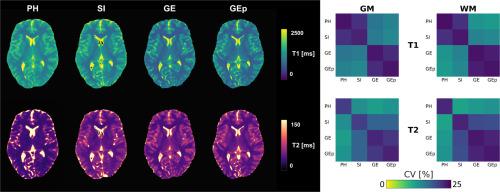关节T1-T2瞬态弛豫测量的可重复性和再现性跨多个供应商和实现在幻觉和人脑的3T。
IF 4.5
2区 医学
Q1 NEUROIMAGING
引用次数: 0
摘要
瞬态弛豫测量(TSR)可以快速估计T1和T2弛豫时间。为了支持其在多中心研究中的广泛采用,有必要评估其在不同MRI供应商之间实施的一致性。这项工作旨在评估基于3T时TSR联合测量的T1和T2地图的准确性、可重复性和供应商间的可重复性。为了实现这一目标,研究人员在三家制造商生产的四套3T核磁共振成像系统上对一个幻影和五名志愿者进行了移动脑扫描。在假体研究中,分别采用Bland-Altman分析和变异系数(CV)评估准确性、可重复性和再现性。随后,通过方差分析评估体内位点间变异性,并通过计算体素cv和一般线性模型(GLM)测量与位点相关的偏差。获得了极好的准确度、重复性和再现性。在体内,我们发现了出色的重复性(CV < 4.5%)和总体上良好的站点间和供应商间的重复性,尽管在不同的TSR实现中发现了显著的差异。GLM分析显示,实体脑组织中T1和T2的位点相关偏差约为100 ms和2 ms。这些差异可能是由于不同的磁化传递效应和由于不完善的校准导致的残留B1+不均匀性。我们的研究结果表明,为了进行体内多中心研究,需要仔细考虑使用不同的TSR实施所带来的偏差。本文章由计算机程序翻译,如有差异,请以英文原文为准。

Repeatability and reproducibility of joint T1-T2 transient-state relaxometry across multiple vendors and implementations at 3T in phantom and human brain
Transient-state relaxometry (TSR) enables rapid estimation of T1 and T2 relaxation times. To support its broader adoption in multi-center studies, it is essential to assess the consistency of its implementation across different MRI vendors.
This work aimed to assess accuracy, repeatability, and inter-vendor reproducibility of jointly measured T1 and T2 maps based on TSR at 3T. To achieve this goal, a phantom and five volunteers were scanned in a traveling-brain study at four 3T MRI systems from three manufacturers.
In the phantom study, Bland-Altman analysis and coefficients of variation (CV) were used to assess accuracy, and repeatability and reproducibility, respectively. Subsequently, in-vivo inter-site variability was evaluated via ANOVA and by computing voxelwise CVs and biases associated with sites were measured via a general linear model (GLM).
Excellent accuracy, repeatability, and reproducibility were obtained for the phantom. In-vivo, we found excellent repeatability (CV < 4.5%) and generally good inter-site and inter-vendor reproducibility, though significant variability was found across different TSR implementations. The GLM analysis revealed site-related biases of approximately 100 ms for T1 and 2 ms for T2 in solid brain tissues. These differences may be attributable to different magnetization transfer effects and residual B1+ inhomogeneities due to imperfect calibration.
Our findings demonstrate that the bias introduced by the use of different TSR implementations needs to be considered carefully in order to perform in-vivo multi-center studies.
求助全文
通过发布文献求助,成功后即可免费获取论文全文。
去求助
来源期刊

NeuroImage
医学-核医学
CiteScore
11.30
自引率
10.50%
发文量
809
审稿时长
63 days
期刊介绍:
NeuroImage, a Journal of Brain Function provides a vehicle for communicating important advances in acquiring, analyzing, and modelling neuroimaging data and in applying these techniques to the study of structure-function and brain-behavior relationships. Though the emphasis is on the macroscopic level of human brain organization, meso-and microscopic neuroimaging across all species will be considered if informative for understanding the aforementioned relationships.
 求助内容:
求助内容: 应助结果提醒方式:
应助结果提醒方式:


